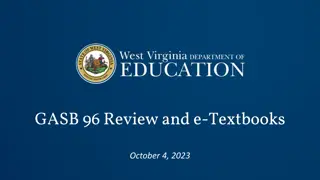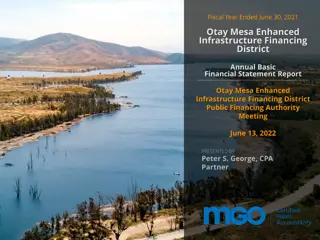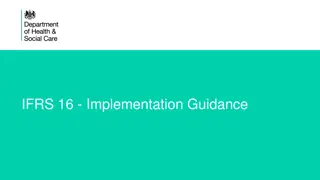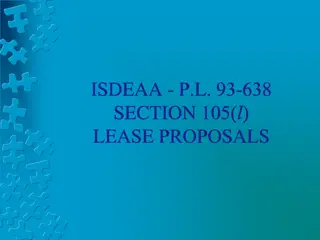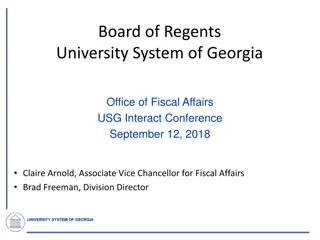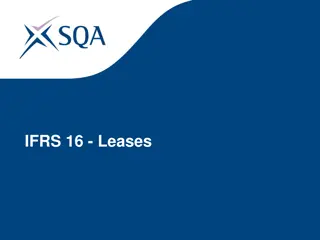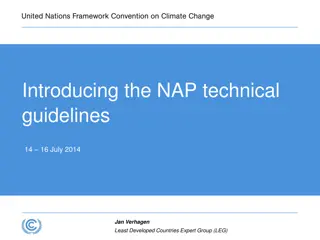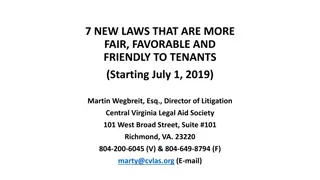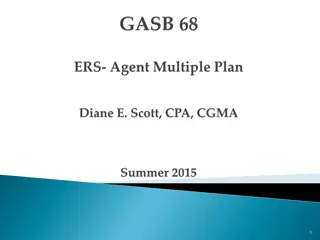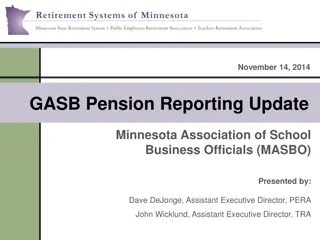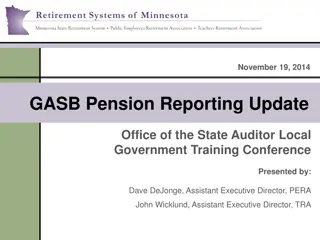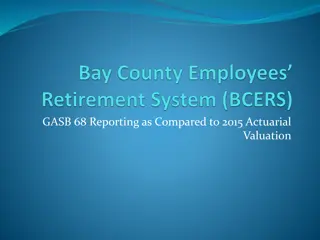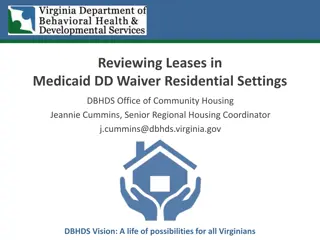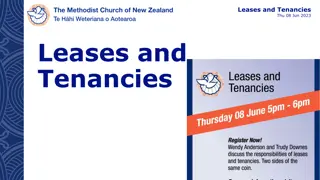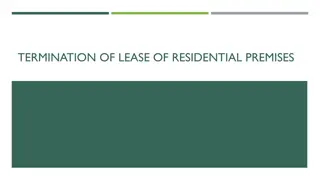Understanding GASB 87 Leases: Key Information and Implementation Guidelines
This informational material focuses on GASB 87 Leases, covering aspects like the definition of leases, exclusions, accounting treatments, and implementation steps for government entities. GASB 87, issued in 2017, aims to enhance accounting and financial reporting for leases by governments through a unified model. The content provides insights into the objectives, agenda, and overview of GASB 87, shedding light on the control and use of nonfinancial assets, lease duration, and accounting considerations. It aims to equip attendees with essential knowledge to prepare for GASB 87 implementation effectively.
- GASB 87 Leases
- Government Accounting
- Lease Accounting Guidelines
- Implementation Steps
- Financial Reporting
Download Presentation

Please find below an Image/Link to download the presentation.
The content on the website is provided AS IS for your information and personal use only. It may not be sold, licensed, or shared on other websites without obtaining consent from the author. Download presentation by click this link. If you encounter any issues during the download, it is possible that the publisher has removed the file from their server.
E N D
Presentation Transcript
GASB 87 Leases Veteran Clerks Webinar December 9 Denise Williams, MASBO Executive Director
GASB 87 Leases OBJECTIVES Make you aware Basic information on the new guidance on accounting for leases Steps on how to prepare for implementation What resources are available to you
GASB 87 Leases AGENDA Overview Definition of a Lease Accounting treatment Resources
GASB 87 Leases OVERVIEW Issued in June 2017 Improves accounting and financial reporting for leases by governments Establishes a single model for lease accounting Leases are financings of the right to use an underlying asset Implementation in FY2022 Initial date was FY2021 GASB 95 postponed implementation to fiscal year beginning after 6/16/2021
GASB 87 Leases DEFINITION OF A LEASE A contract that conveys control of the right to: Use another entity s nonfinancial asset (the underlying asset) For a period of time as specified in the contract In an exchange or exchange-like transaction Examples of nonfinancial assets include Buildings Land Vehicles equipment A contract that meets this definition should be accounted for under GASB 87, unless specifically excluded
GASB 87 Leases EXCLUSIONS Short-term leases defined as At the commencement of the lease term Maximum possible term under the lease contract is 12 months or less Includes any options to extend regardless of probability of being exercised. Accounting treatment Lessee records outflow of resources (expenditures) Lessor records inflow of resources (revenue) Based on the payment provisions of the contract
GASB 87 Leases EXCLUSIONS Contracts that transfer ownership Transfers ownership of the asset to the lessee by the end of the contract Cannot contain termination options Contracts can contain fiscal funding or cancellation clauses as long as it is reasonably certain the clauses will not be exercised Accounting treatment Lessee records purchase of the asset Lessor records sale of the asset
GASB 87 Leases Everything else is a lease LESSEE recognizes a lease liability and a lease asset LESSOR recognizes a lease receivable and a deferred inflow of resources
GASB 87 Leases LEASE TERM Noncancelable period (neither party can cancel the contract) +Periods covered by the lessee s option to: extend the lease terminate the lease +Periods covered by the lessor s option to: extend the lease terminate the lease Where it is reasonably certain they will exercise option to extend Where it is reasonably certain they will not exercise option to terminate
GASB 87 Leases REASONABLY CERTAIN
GASB 87 Leases REASONABLY CERTAIN means more than probable
GASB 87 Leases PARAGRAPH 14 At the commencement of the lease term, the lessee and the lessor should assess all factors relevant to the likelihood that the lessee or the lessor will exercise options to extend or terminate. Contract based factors contractual terms or conditions that provide economic incentives or disincentives Underlying asset based usefulness of the asset at end of lease term Market based market value of asset at end of lease term Government specific is there any history that indicates the gov t exercises options (or not) with past leases
Term of lease begins on delivery that s when the lessee takes control GASB 87 Leases LESSEE ACCOUNTING At the commencement of the lease term, recognize: Lease liability Measure at present value of payments expected to be made during the lease term (interest rate, # of periods, payment amount, residual value) Subtract any lease incentives Lease asset (intangible right to use lease asset) Measure at the amount of the initial measurement of the lease liability, plus Any payments made to the lessor at or before commencement of the lease term, and Certain direct costs
GASB 87 Leases LESSEE ACCOUNTING Lease liability as payments are made: Reduce lease liability Recognize an outflow of resources for interest on the liability Lease asset - amortize Use a systematic and rational method Over the lease term or the useful life of the underlying asset, whichever is shorter Notes to financial statements Description of lease arrangements Amount of lease assets recognized Schedule of future lease payments to be made
GASB 87 Leases LESSOR ACCOUNTING At the commencement of the lease term, recognize: Lease receivable Measure at present value of payments expected to be received during the lease term Subtract any lease incentives Deferred inflow of resources Measure at the value of the lease receivable Any payments received at or before commencement of the lease term that relate to future periods Note: Do not derecognize the asset underlying the lease
GASB 87 Leases LESSOR ACCOUNTING Lease receivable as payments are received Reduce lease receivable Deferred inflow of resources over the term of the lease Reduce in a systematic and rational manner over the term of the lease Revenue Interest on lease receivable payments From deferred inflow of resources (above)
GASB 87 Leases INFORMATION & TASKS NEEDED FOR IMPLEMENTATION Examine existing leases Update chart of accounts Develop recordkeeping systems for Identifying leases Determining lease terms Data needed for calculations, such as Lease term Interest rate Lease payment Renewal dates Amortization of calculated balances
GASB 87 Leases INFORMATION NEEDED FOR IMPLEMENTATION Develop any necessary accounting policy statements that help guide determination of reasonable certainty of exercising extend or terminate options
GASB 96 Subscription-based Information Technology Arrangements (SBITA) Issued in May 2020 SBITA definition: a contract that conveys control of the right to use another party s (a SBITA vendor s) information technology (IT) software, alone or in combination with tangible capital assets (the underlying IT assets), for a period of time in an exchange or exchange-like transaction On the F/S, recognize: right-to-use subscription asset (intangible asset), and corresponding subscription liability
GASB 96 Subscription-based Information Technology Arrangements (SBITA) Implementation: FY2023 fiscal years beginning after June 15, 2022, and all reporting periods thereafter Earlier application is encouraged Why? Existing GASB standards address software that is internally developed or purchased through perpetual licensing agreements GASB 96 addresses cloud computing and other subscription-based forms of software applications and storage
GASB 87 Leases RESOURCES Governmental Accounting Standards Board GASB Statement 87, Leases Implementation Guide No. 2019-3, Leases GASB 96 Subscription-based Information Technology Arrangements Helpful Article Lessee accounting for governments: An in-depth look, (Paretta; Celia) AICPA Journal of Accountancy, August 2019
GASB 87 Leases RESOURCES Helpful video training Eide Bailly, CPAs GASB 87 Lease Workshop Part 1 Basics & Lessees (June 2021) Part 2 Lessors (July 2021) Part 3 - Special Issues, Implementation, GASB-94 and GASB-96 (August 2021)



